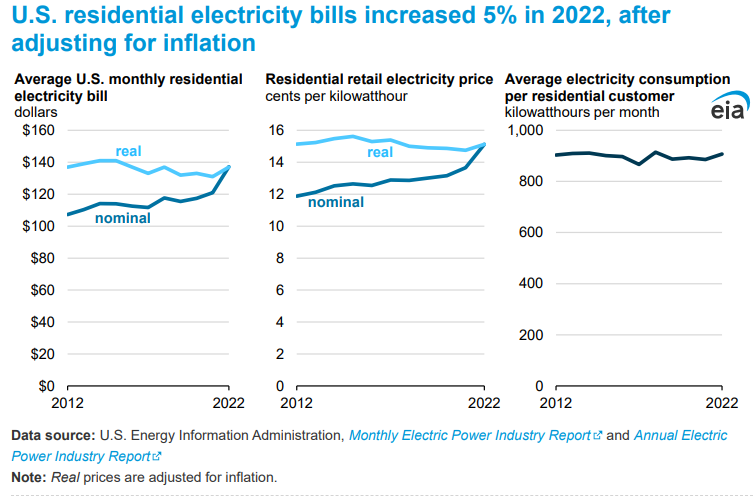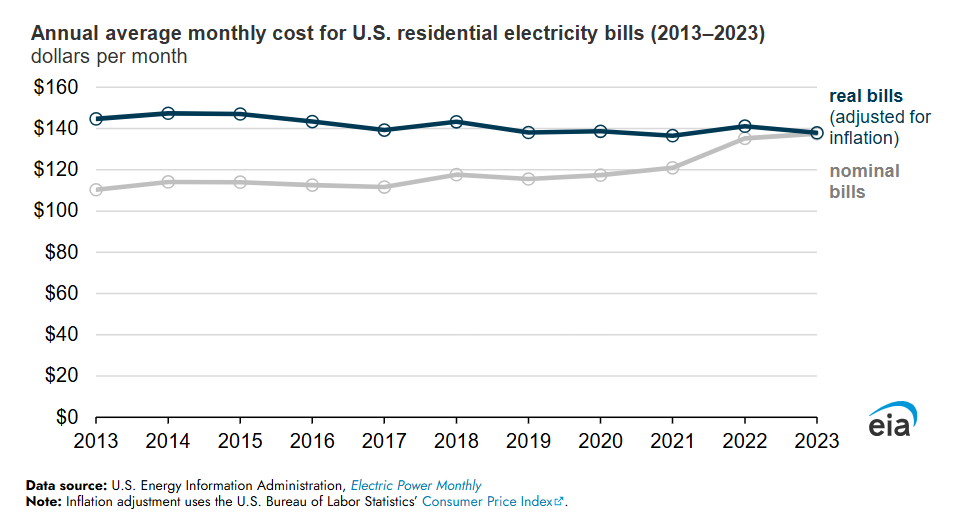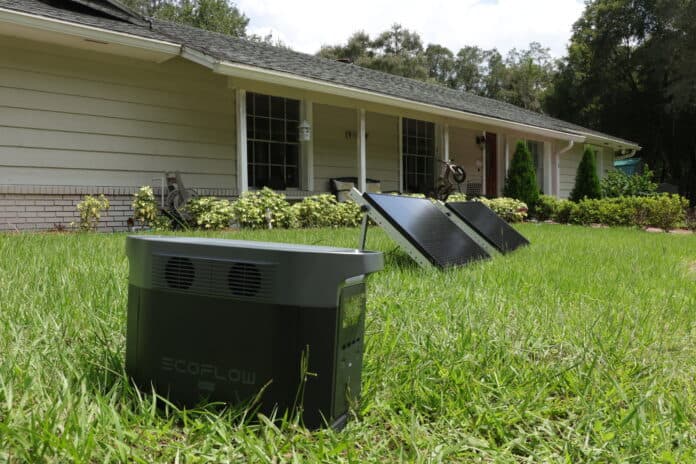Calculating your household energy consumption is essential if you’re looking for ways to save on electricity costs or build a home backup power system.
It’s much easier than it sounds. Calculating how many watts it takes to run your house requires simple calculations and an analysis of your past electricity bills.
Once you dive in, you may be surprised to learn how much electricity you and your family consume on a daily or monthly basis.
So how many watts does your house need to run?
Find out how to calculate your current energy consumption and how it compares to the average household.
How Many Watts Does an Average Home Use?
The wattage required to run an American home varies based on numerous factors, including location, size of the house, and the consumption patterns of the people who live there.
However, there are daily, monthly, and annual residential electricity consumption averages compiled by reputable sources.

(Source: energy.gov)
In 2022, the average monthly electricity bill in the US was $137, a 13% increase over 2021 and a 40-year high when adjusted for inflation.

(Source: EIA)
Electricity bills remained mostly unchanged in 2023 and increased at a slower pace than overall inflation — 2% per month vs. 4.1%.
Based on the data above, the average household electricity bill in America breaks down as follows:
- Daily Average: $4.60
- Monthly Average: $138
- Average Electricity Cost per Year: $1,656
Prices and consumption varied by state, with Hawaii paying the highest price per kilowatt hour, but consuming less electricity than most other states.
According to the EIA, “Residential consumers in Louisiana used more than four times the electricity as those in Hawaii on average” but spent 33% less on their bills.
Consumers in Utah had the lowest bills on average at $87 per month.
In the real world, electricity spending varies significantly — not only over the course of a month but also over a single day.
For example, many households use more electricity at night and in the early morning than during a standard 9-to-5 workday.
High-wattage appliances like coffee makers and hairdryers get used before work; air conditioners and space heaters run at night.
More and more Americans work from home, making them vulnerable to time-of-use pricing and electricity demand charges.
Every household’s consumption patterns are different, but that doesn’t mean you can’t calculate how much electricity you and your family need to run your house.
Let’s take a closer look.
Which Factors Influence How Many Watts Are Needed to Run a House?
Multiple factors can impact overall energy consumption even with households that use similar appliances.
Here are the primary factors that determine how many watts you’ll need to run your house:
The Size of Your House
The square footage of a home significantly impacts electricity consumption.
The more rooms your home has, the more electricity your house requires to heat and cool.
There will also be more lights and potentially more people using the appliances in a larger home.
Your House’s Age and Condition
Older homes built before the widespread adoption of energy-efficient appliances and building materials use more energy than newer homes.
Newer homes are more energy efficient, with better insulation, more efficient HVAC systems, and Energy Star-rated appliances.
Size of Your Household
This may seem obvious, but the more people living in a household, the higher the energy consumption.
Consider the following:
- The more people taking hot showers and baths, the more electricity your water heater consumes
- Major appliances like dishwashers, washing machines, and refrigerators will be used more often
- Lighting and HVAC requirements will increase
Where You Live
Your home’s location plays a significant role in energy consumption.
If you live in a hot climate, air conditioning may be an everyday necessity during the summer — or year-round.
Likewise, people in freezing climates must keep their heating systems running to survive.
Local energy rates also can influence electricity consumption. Residents with higher energy costs tend to be more careful about how much energy they use.
The Number and Type of Appliances
The more large appliances in a household, the higher energy consumption. For instance, a dryer uses much more power than hanging clothes outside to dry. A dishwasher will always use more electricity than washing your dishes by hand.
Older appliances also tend to consume more power. New appliances are usually Energy Star-rated and consume much less electricity.
How Often You Use Electrical Appliances (Lifestyle)
Your family’s lifestyle and appliance usage will significantly affect the wattage required to run your home.
For example, how hot or cold you keep your home will influence energy consumption.
You’ll consume more power if you prefer to keep your home toasty in winter or frosty in the summer.
How much time your household spends using televisions, computers, and washing machines will also impact your energy consumption.
Hourly electricity consumption tends to vary throughout the day, with on-peak hours for most households falling between 7:00 AM-11:00 PM during the week.
Average Home Energy Consumption and Backup Power
The energy consumption of home appliances varies widely based on specific models and usage patterns.
Suppose you’re considering purchasing a portable power station or whole home backup power solution to provide energy security for your family when a blackout strikes. In that case, you need to calculate the electricity requirements of the essential appliances you want to run.
Here’s how.
Determining Your Wattage Requirements
Before using a generator, you will want to determine how much power you need.
- Identify the wattage requirements of your appliances. Survey the starting and running wattage requirements of the appliances and devices you plan to plug into the generator. You can usually find the wattage requirements labeled on the appliance, but we’ve also compiled the starting and running watts of typical household appliances in the table below.
- Convert volts/amps to watts. If your appliance’s power requirements are in volts or amps, you can calculate an appliance’s running watts with this equation:
Volts (V) x Amps (A) = Watts (W)
- Count the running watts of your appliances. Add up the running watts of the appliances you plan to use — does the total exceed the running watts listed on your generator? If so, you should consider buying a generator with more output capacity.
- Factor in starting watt requirements. Identify the appliance with the highest starting wattage. Add that appliance’s starting wattage to the running wattage total.
- Calculate the sum. That final number is the total starting watts you need from your generator. As discussed above, to avoid overloading your generator, do not exceed its starting watts rating.
Starting and Running Watts of Typical Household Appliances
| Appliance | Rated (Running) Watts | Starting Watts |
| Dishwasher | 1300 | 1800 |
| Washing Machine | 1200 | 2300 |
| Refrigerator/Freezer | 700 | 2200 |
| Light Bulb | 60-75 | 0 |
| Microwave | 600-1000 | 0 |
| TV | 500 | 0 |
| Toaster | 900 | 0 |
| Vacuum | 1440 | 2500 |
| Coffee Maker | 1000 | 0 |
| Blender | 300 | 800 |
| Clothing Iron | 1500 | 0 |
| Dryer | 5400 | 7000 |
| Toaster Oven | 1200 | 0 |
| Curling Iron | 1500 | 0 |
| Space Heater | 2000 | 0 |
| Laptop | 50-300 | 0 |
| 20” Box Fan | 200 | 350 |
Frequently Asked Questions
The total wattage required to run a house depends on numerous factors, including home size, number of occupants, and electricity consumption patterns. To determine how many watts it takes to run your home, add up the starting and running watts of all the appliances you want to run simultaneously. For most homes, 5,000W – 10,000W (5kW-10kW) will be sufficient to run your high-wattage appliances and HVAC systems.
Yes, a 7,000W (7kW) generator should be more than sufficient to power most American homes. However, conducting a home energy audit is essential to confirm that 7kW of AC output is sufficient. If you have a large home with multiple occupants, 7,000W may not be enough. Add up the starting and running watts of all the electronics you wish to operate simultaneously and ensure the generator exceeds the total output required by at least 10%.
Yes, a 7,500W (7.5kW) generator should output enough electricity to power most American homes. But it’s essential to perform a home energy audit to make sure. Add up the starting and running watts of all the high-wattage appliances and HVAC systems you want to run simultaneously and ensure the generator exceeds the total output required by at least 10%.
A backup power source or generator that outputs 7,000 – 9,000 watts of electricity is sufficient to power an entire home during a blackout. It’s crucial to keep in mind that you need the ability to store or generate electricity during a blackout. For example, 3.6kWh of storage or generation capacity might see you through a day of average household electricity consumption. For more extended outages, you’ll need to add additional battery storage or solar/fossil-fuel electricity generation capacity.
Final Thoughts
Calculating the total wattage required to run your home can be time-consuming, but if you’re looking to purchase a generator for home backup and energy security, it’s time well spent.
Consider the alternative…
You end up spending a significant amount of money on a generator that fails to meet your family’s needs.
That’s the kind of expensive mistake that nobody wants to make.
Fortunately, EcoFlow’s DELTA Pro Ultra is a modular, expandable home generator that can provide up to 21.6kW of AC output wattage and 90kWh of battery backup storage.
That’s enough to keep the average American home for a month off-grid.
EcoFlow offers solar generators and portable power stations for practically any application.
Check out our selection today.
